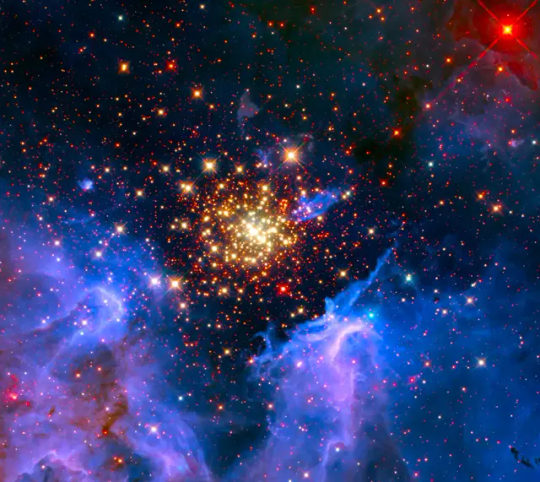Hello! My name is Ana and I’m a part time photographer.
Don't wanna be here? Send us removal request.
Text

5 Facts About Dogs That You Didn't Know
Dogs have wet noses to enhance their sense of smell. The moisture helps to absorb more of the tiny particles we call odors.
Dogs have exceptional night vision compared to humans due to the high number of rods in their retinas.
Dogs have 300 bones in their body when they are born, but as they grow, some of these bones fuse together and they end up with only 206 bones as adults.
Dogs have better low-light vision than humans due to a reflective layer called the tapetum lucidum at the back of their eyes.
Dogs have three eyelids. The third lid, called a nictitating membrane, keeps the eye lubricated when the dog is sleeping.
35 notes
·
View notes
Text

DEM L 190
DEM L 190 is a well-known supernova remnant located in the Large Magellanic Cloud, a satellite galaxy of the Milky Way.
It is associated with the explosion of a massive star and is notable for its bright emission in various wavelengths, including X-rays and radio waves.
Credits: ESA/Hubble & NASA, S. Kulkarni, Y. Chu
301 notes
·
View notes
Text

Did you know that Milky Way and Andromeda galaxies will collide ?
The Milky Way and Andromeda are the two largest galaxies in the Local Group and they are currently on a collision course which is driven by their mutual gravitational attraction.
Galaxies are not stationary objects, but are instead in constant motion, orbiting around each other and moving through the vast expanse of space.
The gravitational forces between them pull them closer together over time. As the two galaxies approach, their gravitational fields will become stronger, accelerating the rate of their collision.
This collision will not be a catastrophic event, but rather a gradual process that will take hundreds of millions of years to complete.
The two galaxies will pass through each other, with stars and other objects from each galaxy interacting and merging with each other.
The resulting galaxy will be a giant elliptical galaxy, with a mass of hundreds of billions of stars.
161 notes
·
View notes
Text

Barred Spiral Galaxy
NGC 2146 is a barred spiral galaxy located approximately 80 million light-years away in the constellation Camelopardalis.
It is an interesting object of study due to its dusty spiral arm that has looped in front of the galaxy's core as seen from our perspective.
Credits: ESA/Hubble & NASA
742 notes
·
View notes
Text
Did you know that space is silent ?
Space is often described as being completely silent. It is a near-perfect vacuum, meaning it has very few particles to carry the sound vibrations.
Sound is a mechanical wave that requires a medium such as air or water to travel through and can't propagate in space because there are not enough molecules to transmit it.
You may now wonder how astronauts communicate? Well they still use a radio to communicate, but the radio waves they use are electromagnetic waves, which do not require a medium to travel.
47 notes
·
View notes
Text

Doomed Star Eta Carinae
Eta Carinae is a massive star system located in the Carina constellation, approximately 7,500 light-years away from Earth.
It is one of the most massive and luminous stars known, with a mass estimated to be around 100 times that of the Sun. Eta Carinae is particularly interesting because it is a binary system, consisting of at least two stars, one of which is a massive, unstable supergiant.
The system is often referred to as a "doomed star" because it is expected to end its life in a spectacular supernova explosion.
Eta Carinae has already undergone significant changes, including a massive outburst in the 19th century that caused it to temporarily become one of the brightest stars in the sky.
Credits: NASA, ESA, Hubble; Processing & License: Judy Schmidt
408 notes
·
View notes
Text

Did you know that the pyramids are aligned with the stars ?
21 notes
·
View notes
Text

NGC 3603
NGC 3603 is a bright and prominent star-forming region located in the constellation Carina.
It is known for its rich population of young, massive stars and is often studied for insights into stellar formation and evolution.
NGC 3603 is approximately 20,000 light-years away from Earth
Credits: NASA, ESA, R. O'Connell (University of Virginia), F. Paresce (National Institute for Astrophysics, Bologna, Italy), E. Young (Universities Space Research Association/Ames Research Center), the WFC3 Science Oversight Committee, and the Hubble Heritage Team (STScI/AURA)
369 notes
·
View notes
Text

Galaxy NGC 4535
NGC 4535 is a barred spiral galaxy located in the constellation Virgo (The Virgin). It is part of the Virgo Cluster and is approximately 50 million light-years away from Earth. NGC 4535 is notable for its well-defined spiral structure and bright central bar, which is characteristic of barred spiral galaxies.
Credits: ESA/Hubble & NASA
512 notes
·
View notes
Text

Westerlund 2
Westerlund 2 is a young open star cluster of 3,000 stars located in the constellation Carina, approximately 20,000 light-years away from Earth. It is notable for its high concentration of massive stars and is estimated to be around 2 million years old.
Credits: NASA, ESA, A. Nota (ESA/STScI), and the Westerlund 2 Science Team
541 notes
·
View notes
Text

Lovely cows❤️
64 notes
·
View notes
Text

Brezoi, Romania
5 notes
·
View notes




